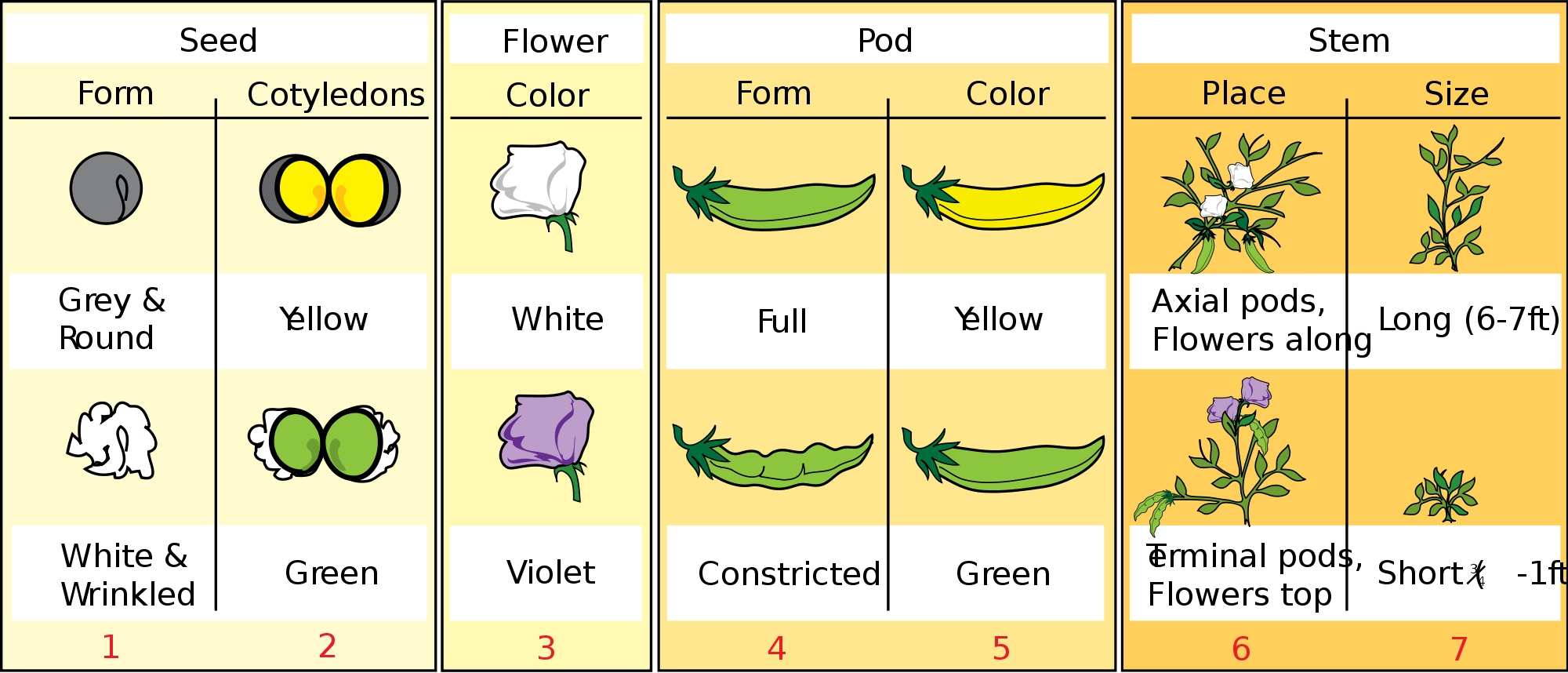How did we come to understand the very blueprint of life? This question has intrigued humanity for centuries. Join us on a journey through time as we explore the fascinating history of genetics. From early philosophical musings to groundbreaking scientific discoveries, we’ll uncover the evolution of our understanding of heredity and the mechanisms that govern life itself. Get ready to dive deep into the science of genetics!
Table of Contents:
- Ancient Insights: Early Theories of Heredity
- The Rise of Preformationism: Miniature Humans
- The 19th Century: Seeds of Modern Genetics
- The Early 20th Century: Rediscovering Mendel and the Rise of Eugenics
- The Dawn of Molecular Genetics: Unraveling the Structure of DNA
- What you can do? Educate yourself!
- Conclusion
Ancient Insights: Early Theories of Heredity
The quest to understand how traits are passed from parents to offspring dates back to ancient times. Even without the advanced tools of modern science, early thinkers proposed intriguing theories to explain heredity.
Pythagoras: The Seed of Life
As early as 2500 years ago, Pythagoras, the famous mathematician, offered one of the first explanations.
Pythagoras posited that males contain all the necessary material for creating a new human being within their semen. He believed that this ‘seed’ carried the essence of life, and the female’s womb simply provided a nurturing environment for it to grow.
Plato: The Mathematical Formula
Plato, a student of Socrates, proposed a different approach. He suggested that we are perhaps defined by a mathematical formula. While Plato conceded we may never fully comprehend the intricacies of this formula, he believed it could hold the key to predicting an offspring’s traits. His understanding of inheritance, as it is now called, could be defined mathematically.
Aristotle: The Role of Both Parents
Aristotle expanded on these ideas, noting that children often resemble their mothers or maternal grandparents. He proposed that both male and female contribute some kind of ‘seed’ during reproduction, which then combines to create a new individual. According to Aristotle, both parents contribute to the raw material from which a child is created.
Galen: The Influence of Heat
Galen, a famous surgeon, argued that heat is the catalyst for life. He believed that the heart’s beating generates heat, which in turn brings life. Galen even went so far as to suggest that the amount of heat determines the baby’s gender. More heat would cause the baby to be a boy and less heat would cause it to be a girl.
The Rise of Preformationism: Miniature Humans
In the 17th century, a new idea emerged known as preformationism. This theory suggested that a fully formed, miniature human (‘homunculus’) exists within either the sperm or the egg. According to this view, development was simply a matter of this tiny human growing larger. This led to the Ovists and Spermists branches of the preformationism theory. If this theory were true, that would have meant when sperm is wasted, it is a mass murder.
Spermists
This branch believed that miniature humans already existed inside a man’s sperm. Once sperm entered a woman’s womb, the fully developed human would grow into a full baby.
Ovists
This branch believed that miniature humans already existed inside a woman’s womb. Once a man’s sperm fertilized the uterus, the fully developed human would grow.
The 19th Century: Seeds of Modern Genetics
The 19th century marked a turning point in our understanding of heredity. Scientific advancements and meticulous experimentation paved the way for the birth of modern genetics.
Scientific Revolution
Europe witnessed a rapid scientific revolution, fueled by the work of giants like Isaac Newton and Galileo Galilei. Physics, chemistry, and biology advanced, yet the question of how offspring inherit traits remained a mystery.
Gregor Mendel: The Father of Genetics
Gregor Mendel, an Austrian monk, conducted groundbreaking experiments with pea plants in the mid-19th century. Through careful observation and analysis, Mendel uncovered the basic principles of heredity. He also became a gardener, performing studies with different peas.
Mendel’s Experiments
Mendel crossed-bred pea plants with different traits, such as height, color, and seed shape. He meticulously recorded the characteristics of each generation, revealing patterns of inheritance.

Mendel’s Laws
Mendel’s work led to the formulation of three fundamental laws of inheritance:
- Law of Segregation: Each individual has two versions of a gene, one from each parent, and these genes separate during reproduction.
- Law of Independent Assortment: Genes for different traits are inherited independently of each other.
- Law of Dominance: Some traits are dominant and mask the expression of recessive traits.
Mendel documented these findings on page 52 of his experiments. He even attempted to replicate them with mice but the church forbade that because of incest. While he sent this finding to people and societies, it was cast aside because of his lower societal status. He died in 1884, uncelebrated and all but unknown.
Charles Darwin: Evolution and Natural Selection
Around the same time as Mendel’s experiments, Charles Darwin was developing his theory of evolution by natural selection. Darwin’s observations during his voyage on the HMS Beagle led him to propose that species change over time through a process of adaptation to their environment.

In the ship, HMS Beagle, he discovered different beaks on birds from island to island.
Darwin’s Influences
Two key books influenced Darwin’s thinking:
- Divine Watchmaker: William Paley argued that living organisms are complex and purposeful creations.
- Preliminary Discourse on the Study of Natural Philosophy: John Herschel emphasized the importance of finding a natural explanation for the origin of species (‘the mystery of mysteries’).
The Theory of Natural Selection
Darwin proposed that individuals with traits that are better suited to their environment are more likely to survive and reproduce, passing those advantageous traits to their offspring.
This process, known as natural selection, drives the evolution of species. Three main components of this theory are Offspring Variations, Limited Resources, and Competition. It was a revolutionary idea at the time because of its stark contrast to religious explanations.
Darwin’s Dilemma: The Mechanism of Heredity
However, Darwin’s theory lacked a clear explanation for how traits are passed from parents to offspring. He proposed a theory called Pangenesis, which suggested that particles called ‘gemmules’ carry information from all parts of the body to the reproductive organs.
The Early 20th Century: Rediscovering Mendel and the Rise of Eugenics
As the 20th century dawned, Mendel’s forgotten work was rediscovered. However, this newfound knowledge was tragically twisted to support the rise of eugenics, a movement that sought to ‘improve’ humanity through selective breeding.
The Cell and Chromosomes
In 1882, Walther Flemming identified structures that he would call chromosomes.

Chromosomes were a critical piece of genetics history; however, at the time, no one knew about the connection between chromosomes and Darwin.
Rediscovering Mendel
Around 1900, three scientists—Hugo de Vries, Carl Correns, and Erich von Tschermak—independently rediscovered Mendel’s work while conducting their own experiments on heredity.
At the time, the three scientists all acquired the same findings as Mendel’s papers. Deciding to publish his findings first, Hugo de Vries published, without giving any credit to Mendel.
In response, Carl Correns accused De Vries of stealing and claimed what he did was plagarism. Despite the controversy, the word of Mendel’s findings was out. His concepts and experiments had finally been realized.
Hugo de Vries and Mutations
Hugo de Vries popularized Mendel’s studies and introduced the concept of mutations. He defined mutations as changes in the genetic information of an organism.
William Bateson and Mendelism
William Bateson, a British biologist, was a strong advocate for Mendel’s laws. He named the study of inheritance as genetics. He, unlike other at the time, fully supported Mendelism.
The Dark Side of Genetics: Eugenics
Unfortunately, the new understanding of genetics was also misused to promote harmful ideologies. Eugenics, coined by Francis Galton, was a movement that sought to ‘improve’ the human race through selective breeding. He even published a book titled, “Inquiries into Human Faculty and its Development.”
Being the cousin of Charles Darwin, Galton’s work was widely viewed. Unfortunately, it was also wildly inaccurate. He even tried to improve his own work by stitching different parts of different animals together. Then, he shifted his focus to eugenics.
Eugenics in the United States
While traveling the world, Galton would classify woman and other individuals based on features and rating them on which ones he would call desirable. This idea traveled to the United States where the people there began to separate people, with the primary separation being white and black people.
This, it was incorrectly and widely believed, would lead to a superior world. Then, people who were viewed as feeble minded, were forcibly sterilized in the United States. This idea lead to Buck vs Bell.
Buck vs Bell
Emma Buck, who had been a victim of prostitution, was deemed as feeble minded. Her daughter went into foster care, and she was deemed feeble minded as well. A doctor then suggested that her daughter would also be sterilized to prevent the contamination of genetics.

Eugenics in Russia
During the reign of Russian royalty, Prince Alexi suffered from a genetic disease named Hemophilia. Grigori Rasputin was called as a healer, gaining political influence because he helped Alexi. The public, thinking that Rasputin was polluting their leader, assassinated Rasputin which lead to Russian protests.
Eugenics in Nazi Germany
With the ascent of the Nazi Party, eugenics took a horrific turn. Inspired by eugenic ideas from the United States and Britain, the Nazis implemented policies aimed at ‘purifying’ the Aryan race.
This led to the forced sterilization of individuals deemed ‘unfit,’ including people with disabilities, Roma people, and Jews. Later, the Nazis began the T4 euthanasia program where kids were killed because they were viewed as flawed or feeble minded. Finally, eugenics gave way for the name, genocide. This was a dark time for genetics.
The Dawn of Molecular Genetics: Unraveling the Structure of DNA
Following World War II, genetics entered a new era with the rise of molecular biology. Scientists began to unravel the structure of DNA, the molecule that carries genetic information. DNA is like a detailed instruction manual, containing all the information needed to build and operate a living organism.
Erwin Schrödinger: What Is Life?
In 1944, physicist Erwin Schrödinger published a book titled What Is Life? In the book, Schrödinger proposed that genetic information is encoded in a molecule, he says is known as DNA. While there was no definitive proof. This was a key finding in genetics history.
What you can do? Educate yourself!
Learn about genetics to prevent repeating history again. This history of genetics stream is intended to educate people to never again repeat these same horrifc mistakes.
Disclaimer
To ensure clarity and understanding, here are definitions of common terms used throughout this article:
- Genetics: The study of heredity and the variation of inherited characteristics.
- Heredity: The passing of traits from parents to offspring.
- Traits: A characteristic or feature of an organism.
- Genes: Units of heredity that determine traits.
- Chromosomes: Structures within cells that contain genes.
- DNA: Deoxyribonucleic acid, the molecule that carries genetic information.
- Mutation: A change in the genetic information of an organism.
- Eugenics: A discredited movement that sought to improve the human race through selective breeding.
- Phenotype: The physical characteristics of an organism.
- Genotype: The genetic makeup of an organism.
- Homosexuality: Sexual attraction to the same sex.
- Feeble Minded: Lacking the mental capacity to make sound judgments.
- Pangenesis: Darwin’s theory that particles carry info from the body.
- Gemmules: The particals that Darwin believed carry the info from body
- Y Chromosome: Carries male sex characteristics.
- X Chromosome: Carries the female sex characteristics
- Sterilization: Removing one’s ability to reproduce
- Natural Selection: Individuals who adapt more to their environments are more likely to survive.
- Holocaust: The killing of millions of people during world war 2.
- Genocide: The deliberate killing of a group of people.
- Menses: Menstrual cycle
- Schizophrenia: Mental disorder
- Hemophilia: Disease in which blood does not clot normally
Conclusion
The history of genetics is a testament to human curiosity and the power of scientific inquiry. From ancient speculations to the complexities of molecular biology, our understanding of heredity has come a long way. However, it also serves as a stark reminder of the dangers of misusing scientific knowledge to justify prejudice and discrimination. Now that we can manipulate the building blocks of life, should we? The journey continues, with ongoing research promising new insights into the very nature of life.
Read More about Scientific Revolution in Europe.
Find out how Science triumphed over Religion.
Do you disagree with this article? If you have strong evidence to back up your claims, we invite you to join our live debates every Sunday, Tuesday, and Thursday on YouTube. Let’s engage in a respectful, evidence-based discussion to uncover the truth. Watch the latest debate on this topic below and share your perspective!

